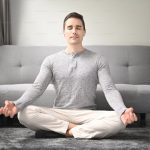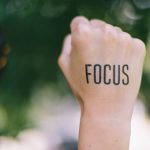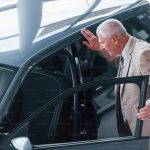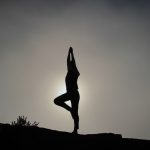Matthew Sanford is a paraplegic and a yoga teacher, and in the crucible of his journey he has learned something we all need to hear.
When Matthew was just 13 years old he was involved in a devastating car crash on the road to his hometown of Duluth, Minnesota. The crash killed his father and older sister, and left him paralysed him from the chest down. What immediately followed this life-defining event was six months of hospital care, ranging from experiences of brutal pain, when he had a metal brace screwed into his skull, to mind-numbing boredom, waiting for his body to knit itself together again. Once he moved home, there were the equally hard years of reintegration with society, and trying to live what doctors told him could be a ‘normal life’.
Matthew’s Search For Meaning
Except it wasn’t normal any more. Nearly everything that those with healthy bodies take for granted was a struggle. He would never walk again, run again, play sport again. The medical professionals encouraged him to believe that by bulking up his arms he would be able to compensate for his lack of working legs, which slowly led to a kind of living part-death. At one point, he even asked for his legs to be amputated as they were surplus to his bodily requirements. The surgeons said ‘no’, but only because they provided the ballast to balance his upper half.
But Matthew was and is no ordinary person, he had a nagging feeling that “there was a purpose to what I had experienced.” This purpose came the surface as he gradually realised that although he couldn’t move or feel the muscles of his paralysed body, that didn’t mean it wasn’t part of him. “If I was going to live,” he says, “I needed to live the mind-body relationship my life had dealt me. My arm strength didn’t have to overcome it.”
This purpose led him, at the age of 25, to the door of a yoga teacher.
Is Yoga Possible For The Paralysed?
The first time Matt met his teacher Jo Zukovich, he was nervous. He didn’t know what she’d think of him: a young man in a wheelchair, paralysed from the waist down. But from the moment they introduced themselves, they had “love at first purpose.” Teacher and student met, and a relationship based on mutual trust and respect was immediately born.
One of the very first things she asked him to do was to take his legs wide into Wide-Angle Seated Pose (Upaviṣṭha Koṇāsana). This simple pose produced in him a euphoric feeling of flying; for the first time in twelve years his legs were wide apart. She asked him to put his hands into prayer. Again, he felt an energetic connection revealed to him through the pose itself.
Matthew realised that his ‘disability’ had an unexpected advantage. “I received something in exchange for absorbing so much trauma at age thirteen. I experience a more direct contact with an inner presence of consciousness — the heart of the artichoke. Although my life has taken much away, it has also revealed a powerful insight.”
Finding A Meaningful Connection
This lesson of conscious connection is what Matt brought with him out of the fire of his near-death experience. For him, the energetic core of the pose is self-evident:
“It is easy to see how yoga clarifies the connection between mind and body. The mindful practice of particular physical movements combines mind and body into a unified experience.”
Through this understanding he teaches us that, most of the time, we inhabit our bodies mindlessly. Our bodies go through the motions, while our minds are somewhere else.
When you think about it, our healthy bodies can put us at a disadvantage. The list of things we take for granted is a long one. We are unaware of unused corners and crevices of our bodies, we look out from behind our eyes, feel only with our hands. Our feet are far away, and are there to be walked on. Our legs fall into habitual positions, crossed over. We stand on one hip, resting our weight on one side of our body. All these mindless habits and more are the usual way that we exist.
Matthew tells us that through the practice and discipline of yoga we can change the relationship we have with our bodies. Slowly but surely, by putting our feet above our heads, by spreading wide, by consciously placing our bodies into positions that are alien and non-habitual, we can learn to re-inhabit our bodies. “I start to realize new ways to feel my body, to gain presence, not on the outside but on the inside. I begin to feel a different kind of life.”
Finding Gratefulness
The other lesson Matthew can teach us is to connect with our body as it is, without ungratefully wishing ourselves a different size, shape or level of flexibility. As he says, “The mind and body that I have are the only mind and body that I have. They deserve my attention. And when I give it, I receive so much more in return.”
What we now have to do is choose to use it. Matthew reminds us that the power to connect with our physical form is open to us at any given moment. “Consciousness does not abandon us. It is only denied.”
“When I watch relatively healthy people ride the moving sidewalks in airport terminals or take an elevator up a single floor, I wonder about these choices,” he says. He doesn’t judge these people, but simply makes the point that “the choices we make define how we interact with our bodies, and they shape our consciousness.”
Finding Ourselves
Matthew believes that the underlying principles of yoga provide all the tools we need to consciously connect with our bodies. Have a look at yourself now, as you read this article. My guess is you are sitting cross-legged in a chair, or perhaps slumped forward, chin resting on your hand. Matthew has some advice for you:
“Now, sit up straight, lift the chest, broaden across the collarbones, and extend out through the top of the head.”
This simple instruction to sit up straight activates the mind’s attention drawing it to the alignment of your spine, to the position of the legs, and all the way down to the placement of the feet.
We have to learn to change our habits so that our mind isn’t only switched on to our bodies for a split second, but most of the
time. “As a paraplegic, I can no longer rely on the normal course of my daily life to ensure a healthy connection between my mind and my body. The same is true for all of us.”
To learn more about Matthew’s story, take a look at his book, Waking, written by Matthew Sanford, published by Rodale. Matthew Sanford is the founder of Mind Body Solutions, he speaks nationally about the mind-body relationship and teaches yoga across the globe.













